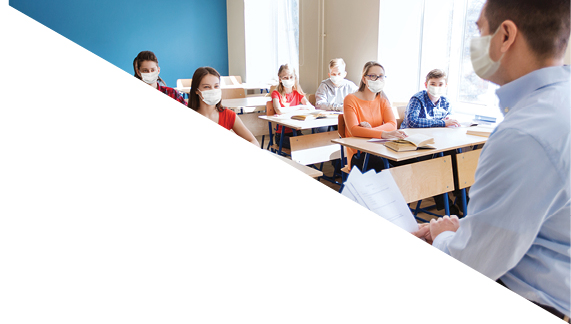Viewpoint: April 2021

As students amid a pandemic, we were afraid that school would turn into a completely lecture-based experience. However, Rosa Parks Middle School (RPMS) in Olney, MD, has gone in a different direction—even trying to make lunch fun although we are on Zoom. Throughout the pandemic, RPMS has done a superior job with virtual learning. They have made parts of our lives easier as students.
Taking Time for Students
Scheduling is one of the first things that comes to mind when thinking about how RPMS has made our lives easier. Students are given a 15-minute break between classes. Although no one has to transition through the hallways to attend their next class, the extended time is much needed. We can log in to our next session and then get up from our computers to move around before sitting down for another class. This way, wellness can be incorporated into every period. Also, Montgomery County Public Schools (MCPS) has provided a great wellness break in the middle of the day. This break is crucial to being able to get away from the computer and to attend to other tasks at home or get outside for some fresh air.
As another part of the remote schedule, students are given an asynchronous day on Wednesdays to check in with teachers as needed. By creating a schedule that considers the needs of all students, RPMS and MCPS have truly tried to provide success for all students during this challenging time.
Teachers are also working hard to create engaging lessons through Zoom classes. Instead of just providing students with independent work, they allow students to engage in friendly competition via Kahoot!, Quizizz, and Nearpod. These tools help students feel connected, not only to our school and teachers but also to our peers. By incorporating these websites, teachers instill in their students a desire to learn and do their absolute best in a virtual environment.
More help came through flexible due dates. In the beginning, virtual learning challenged many students. All at once, students had to adapt to being fully online with many tasks to complete. In the digital environment, it is easy to fall behind or get lost in an assignment. However, teachers encouraged students to work at a pace that suits them. Gone are the days where homework is assigned and due within 24 hours—students now have at least two days before homework is due, which better fits each student’s needs.
Building Solid Relationships
One of the best things that our school has done throughout the pandemic is to encourage teacher-student relationships. In a normal year, it is easy to get to know the adult in the classroom that you spend almost five hours a week with. During the pandemic year, teachers and students were interacting for about two hours a week. A lot of the teachers at RPMS have done a great job of connecting with their students. It is the best feeling to be greeted as you are logging on to your Zoom class. Students need to hear from their teachers and feel like they can trust them and ask any questions.
A lot of our teachers use breakout rooms to connect with students. Allowing students to work in an individual breakout room gives them the confidence to ask their teacher questions. Also, when calling for help, it only alerts the teacher and not the entire class. Teachers also use breakout rooms to check in on each student individually. This allows students and teachers to check in with each other and provides additional opportunities to learn about each other’s interests. Just a simple inquiry like “How are you?” or “What have you been up to?” is so welcoming and sends a message to students that teachers care, even in a virtual environment.
RPMS has taken distance learning by storm and continues to use different ways to connect with students. By creating a flexible schedule, students feel motivated, encouraged, and comfortable to interact with their teachers and to take charge of their education.
Kennedy Ladd, Lindsey Le, Abby Sorkin, and Peyton Williams are all eighth graders at Rosa Parks Middle School in Olney, MD.
Sidebar: Building RanksTM Connections
Dimension: Reflection and Growth
Supporting staff members and students in reflecting on practice and feedback. Supporting reflection and collective understanding of individual strengths and areas for improvement can result in an environment receptive to feedback. When teachers reflect on their own decisions, actions, and growth, they are also more likely to lead classrooms that foster students’ own individual reflection and metacognition. As a principal, you can also explicitly train staff members on delivering and receiving feedback—skills they can use with one another and with students. When staff members are comfortable receiving feedback and reflecting on how to improve their practice, they are not only able to improve their own practice, they are also better able to foster student reflection that furthers student learning.
Reflection and Growth is part of the Leading Learning domain of Building Ranks.
